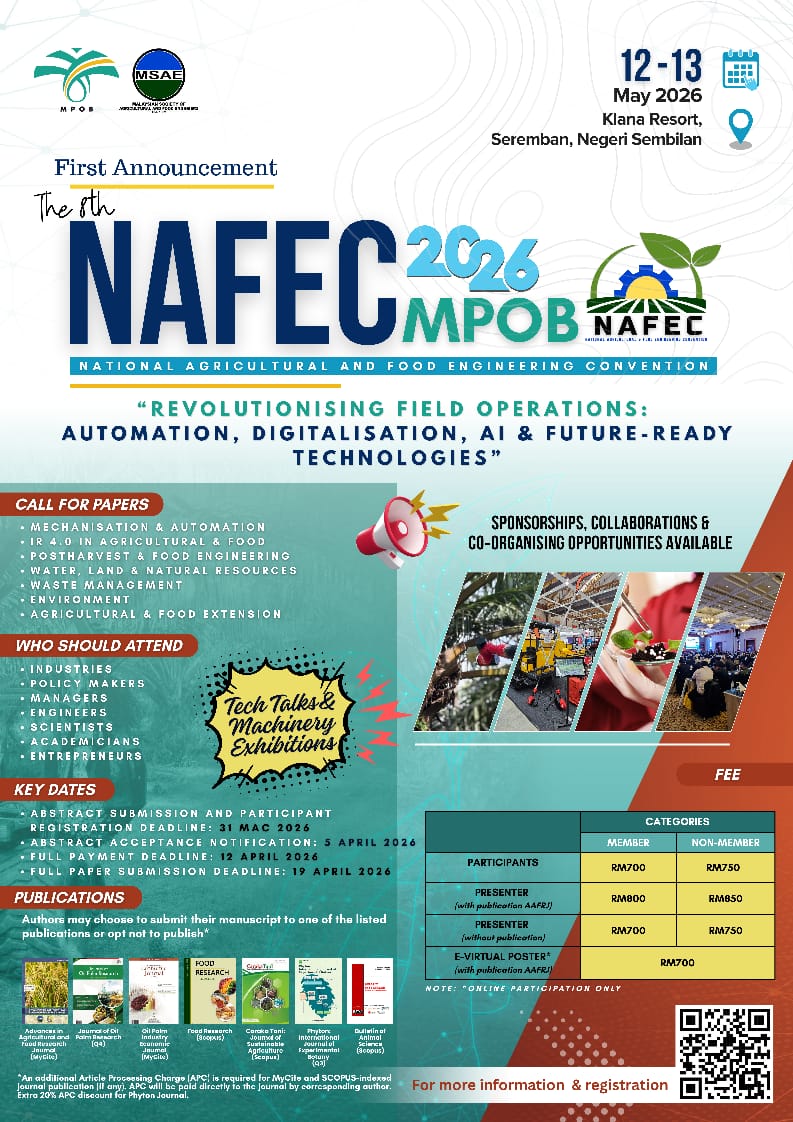Fertiliser Concentration Detection by Means of Hydroponic Root Zone Cooling System on Roof Top Garden for Lactuca sativa Cultivation
DOI:
https://doi.org/10.36877/aafrj.a0000144Abstract
Nutrient film technique (NFT) is a hydroponic technique, whereby a very shallow stream of water containing all the dissolved nutrients required for plant growth is re-circulated past the bare roots of plants in a watertight gully, also known as channels. Problems commonly associated with NFT hydroponic system such as water temperature, can easily increase under direct sunlight in the tropics region, especially in the roof top garden, that can affect the quality of fertiliser used to cultivate the crop. Therefore, a study to develop a cooling system for NFT hydroponic technique is significant to control the water-dissolved nutrient temperatures suitable for crop growth. This paper highlights the studies conducted on fertiliser concentration distribution in the NFT hydroponics root zone cooling (HRZC) system for Lactuca sativa cultivation on roof top garden under the influence of water temperature, air temperature, relative humidity and ambient carbon dioxide. The fertiliser concentration distribution is determined by taking the electric conductivity (EC) reading of the fertiliser flowing along the NFT channels within three targeted points (left, middle, right) atfour different height levels of the cultivation beneath the roof top garden. The EC readings of the fertiliser remained steady, except for the tank along the levels from left, middle and right locations ranging from 1.64–1.66 µS. The water temperature, air temperature, relative humidity and ambient carbon dioxide fluctuated along these three points ranging from 20.50–22.80°C, 31.39–32.23°C, 67.06–68.65%, and 459.39–472.13 ppm, respectively. It was found that under the influence of those environment parameters and NFT root zone cooling system with different level and height, the fertiliser concentration distribution from point to point of data taken is not significantly different along the NFT channels. This finding is significant that integration of NFT root zone cooling system is an alternative to Lactuca sativa cultivation on roof top garden, despite the affecting surrounding temperature that may affect the quality and quantity of fertiliser and crops cultivation. This technique can be extended for the cultivation of other hydroponic vegetables, rice and flowers and promote the culture of roof top farming in the society to avoid the highly polluted soil on the ground environment that may bioaccumulate into the plant system that may ended up as a health threat to fellow consumers.
References
Reference
Amado, T. M., Valenzuela, I. C., & Orillo, J. W. F. (2016). Horticulture of lettuce (Lactuvasativa L.) using red and blue LED with pulse lighting treatment and temperature control in snap hydroponics setup. Jurnal Teknologi, 78, 67–71.
Baek, M. S., Kwon, S. Y., & Lim, J. H. (2016). Improvement of the crop growth rate in plant factory by promoting air flow inside the cultivation. International Journal of Smart Home, 10(2), 63–74.
Chen, W. T., Yeh, Y. H. F., Liu, T. Y., & Lin, T. Te. (2016). An automated and continuous plant weight measurement system for plant factory. Frontiers in Plant Science, 7, 1–9.
Engelen-Eigles, G., Holden, G., Cohen, J. D., & Gardner, G. (2006). The effect of temperature, photoperiod, and light quality on gluconasturtiin concentration in watercress (Nasturtium officinale R. Br.). Journal of Agricultural and Food Chemistry, 54(2), 328–334.
Hasegawa, Y., Yamanaka, G., Ando, K., & Uchida, H. (2014). Ambient temperature effects on evaluation of plant physiological activity using plant bioelectric potential. Sensors and Materials, 26(7), 461–470.
Lee, J. G., Choi, C. S., Jang, Y. A., Jang, S. W., Lee, S. G., & Um, Y. C. (2013). Effects of air temperature and air flow rate control on the tipburn occurrence of leaf lettuce in a closed-type plant factory system. Horticulture Environment and Biotechnology, 54(4), 303–310.
Lee, R. J., Bhandari, S. R., Lee, G., & Lee, J. G. (2019). Optimization of temperature and light, and cultivar selection for the production of high-quality head lettuce in a closed-type plant factory. Horticulture Environment and Biotechnology, 60(2), 207–216.
Maneejantra, N., Tsukagoshi, S., & Lu, N. (2016). A Quantitative Analysis of Nutrient Requirements for Hydroponic Spinach (Spinacia oleracea L.) Production Under Artificial Light in a Plant Factory. Journal of Fertilizers & Pesticides, 7(12), 2–5.
Ryu, D. K., Kang, S. W., Ngo, V. D., Chung, S. O., Choi, J. M., Park, S. U., & Kim, S. J. (2014). Control of temperature, humidity, and CO2 concentration in small- sized experimental plant factory. Acta Horticulturae, 1037, 477–484.
Sakamoto, M., & Suzuki, T. (2015). Elevated Root-Zone Temperature Modulates Growth and Quality of Hydroponically Grown Carrots. Agricultural Sciences, 6(8), 749–757.
Shamshiri, R. R., Kalantari, F., Ting, K. C., Thorp, K. R., Hameed, I. A., Weltzien, C., Ahmad, D., & Shad, Z. (2018). Advances in greenhouse automation and controlled environment agriculture: A transition to plant factories and urban agriculture. International Journal of Agricultural and Biological Engineering, 11(1), 1–22.
Tamura, Y., Mori, T., Nakabayashi, R., Kobayashi, M., Saito, K., Okazaki, S., Wang, N., & Kusano, M. (2018). Metabolomic evaluation of the quality of leaf lettuce grown in practical plant factory to capture metabolite signature. Frontiers in Plant Science, 9, 1–11.
Downloads
Published
How to Cite
Issue
Section
License
Copyright (c) 2020 Ahmad Syafik Suraidi Sulaiman

This work is licensed under a Creative Commons Attribution-NonCommercial 4.0 International License.
Author(s) shall retain the copyright of their work and grant the Journal/Publisher right for the first publication with the work simultaneously licensed under:
Creative Commons Attribution-NonCommercial 4.0 International (CC BY-NC 4.0). This license allows for the copying, distribution and transmission of the work, provided the correct attribution of the original creator is stated. Adaptation and remixing are also permitted.

This broad license intends to facilitate free access to, as well as the unrestricted reuse of, original works of all types for non-commercial purposes.
The author(s) permits HH Publisher to publish this article that has not been submitted elsewhere.

.png)

.jpg)



